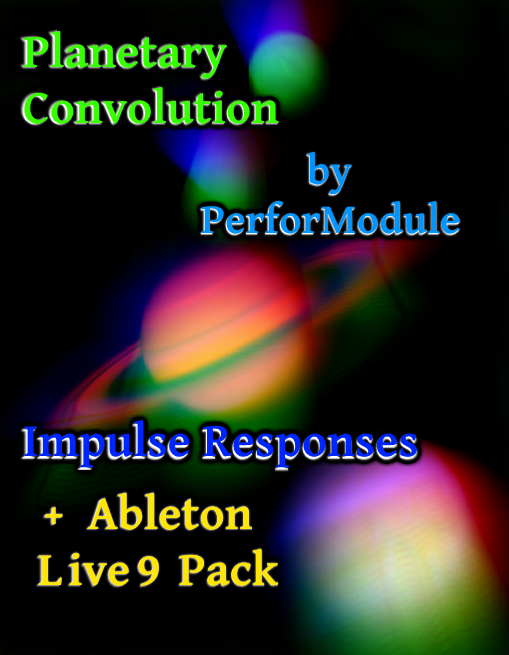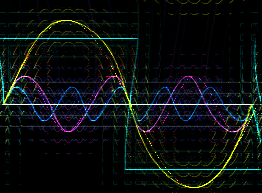Now unveiling “Planetary Convolution” – a pack of Reverb Impulse Responses, each based on a planet (including dwarf planets!) in our Solar System.

They were created using different custom settings of Ableton’s built-in Reverb Algorithm, re-sculpted into Impulse Responses, and then further enhanced.
Each is presented as a “Convolution Reverb Pro” preset for Ableton Live 9 (+MaxForLive) with individual IRs, tone control parameters and a special 1-knob extra effect each.
Using Ableton Live, the presets will open with their corresponding impulse files automatically.
Non-Ableton users can use the IRs too… just open them with your favorite Convolution plugin (though you won’t have access to to the custom EQ shaping parameters and bonus FX, sorry).
“Planetary Convolution” is available at Isotonik Studios. <<<<—- Click Here.
(If you’d like to snag some original Convolution Reverbs by PerforModule for FREE… check these out: GT-8 Convolution & Fostex MR8 MKII Convolution.)
Now for an overview of the Impulse Responses that come with “Planetary Convolution”.
Mercury Reverb_
Has a sizzling, bright tone, like you’re getting fried by the sun.
Xtra FX: “Liquid” – adds a creamy movement; molten.
Venus Reverb_
Sandy-sounding with a smooth high end.
Xtra FX: “Scorch” – adds a subtle fuzz which is affected by the tone control. Also has an enhanced “Thick Chorus” control.
Earth Reverb_
Our good ol’ home planet, you know? This has a medium room sound, good for hip hop drums. The overall tone is (you guessed it) earthy.
Xtra FX: “Gravel” – this adds a nice gritty, chalky color to the reverb.
Mars Reverb_
This reverb has a punchy, forthright quality. It is well-suited for march-style drum patterns, brass, or other high-energy instruments.
Xtra FX: “Anger” – dials in some burning bite to the sound.
Jupiter Reverb_
This reverb has a ridiculously long and smooth tail (25.6 seconds to be precise). Use this for extreme spaciousness and super fade-outs.
Xtra FX: “Storm Swirl” – adds movement to the sound as you get carried along the current.
Saturn Reverb_
Very large and with a resonant, ringy quality.
Xtra FX: “Rings Twirl” – take a trip along the concentric circles.
Uranus Reverb_
Has a billowy texture, as if enveloped in thick fog.
Xtra FX: “Vapor” – adds a smoky layer of reverbish decay.
Neptune Reverb_
Has an icy, chilly spaciousness.
Xtra FX: “Frost” – dial in some crystalline crunch.
Pluto Reverb_
Very small, very cold. Just listening to it will drop your body temperature by a few degrees.
Xtra FX: “Interior” – fade into the interior cavity of the sphere. It must be hollow?
Eris Reverb_
A lesser-known dwarf planet, Eris is known as the Goddess of Chaos, having a bizarre orbit.
It has a short, foreboding sound, like the feeling of someone watching over your shoulder.
Xtra FX: “Dirt” – adds a muted, broken darkness.
~`~
By Style_
Booth Type (very small)
-Pluto
-Eris
Room Type (small)
-Mercury
-Venus
-Earth
-Mars
Hall Type (large)
-Uranus
-Neptune
-Saturn
Epic Type (vast)
-Jupiter
`~`

Ableton Racks Macro Controls_
Dry/Wet: Convolution Reverbs tend to be quite lush, and often are audible at even 1% wet. These start at 23% as a default starting position — make sure to adjust this carefully to not over-apply reverb.
Tone: Starts in the middle by default. Each planetary reverb has its own unique band-interactive filtration which will occur upon moving the “Tone” control up or down. If you have the EQ pane open you will see the visualizer of the audio input spectrum and the EQ curves. After adjusting with the “Tone” dial, you can grab any of the 3 individual EQ nodes and adjust them by hand to fine-tune (they are not locked to the macro). However, once you move the tone knob again, that planet’s custom filter curve will take over again.
Distance: This begins at the default (normal) setting. Turning it down will make the object sound closer; turning it up will make it sound further away. Use this to alter the spatial depth of elements in a mix.
______ (Special Effect): This Macro is named differently for each planet, and has a different sonic effect on each.
Predelay: The time before the reverb first begins. Can be useful for preserving your original transients or adding a stuttered rhythmic feel.
Chorus: Adds a subtle creamy stereo movement. The planet Venus has a more extreme “Thick Chorus”.
Stereo Width: Lower settings place the reverb at the middle of the stereo field; greater settings lead to more spread, up until the maximum possible.
Also: Using controls on the Convolution Pro device (which aren’t mappable to the audio effect rack), one is able to lengthen or shorten the decay, shorten or lengthen the size, combine 2 different planet IRs attack and decay sections, alter the shape of the early reflections and length, cause “cascade” overlapping of decay curve, implement reverb fade-in or fade-out, adjust the Damping Curve (basically the EQ for the decay), or even flip into a reverse reverb.
Grab PLANETARY CONVOLUTION at Isotonik Studios by clicking >>>>>>>>>>HERE<<<<<<<<<<<
Includes:
-“Planetary Convolution” self-installing Ableton Live Pack. Simply drag the .alp file into Live to install it, and the presets will show up in the “Room” and “Hall” folders under “Places”. BAM. That easy.
-“Planetary Convolution” set of .aif Stereo Impulse Responses (L + R files). These are for anyone who doesn’t have Live.
Provided as a single zip file to download. Once unzipped:
If using Ableton Live: use “Planetary Convolution by PerforModule.alp”
If using another DAW: use “Planetary Impulse Responses” zip file. Unzip it and find the aif IR files inside for usage in your Convolution plugin of choice.
Audio Demo_
~`~
ps. On the topic of celestial bodies, check out the “moon reverb” ableton preset which comes with “PerforModule – Dephaultz”.















